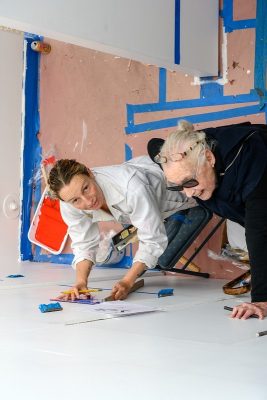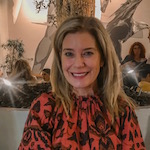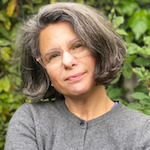Supergraphics pioneer Barbara “Bobbie” Stauffacher Solomon is a Stinson Beach local and a San Francisco native. The 2019 refresh of The Sea Ranch Lodge, along with the unveiling of a new graphic in the lobby and the current exhibition of works on paper, has led to a celebration her work and her iconic Supergraphics, a design trend that is synonymous with the 1960s and 70s.
The work at The Sea Ranch represents key Supergraphics elements — large, bold stripes and shapes using colors like nautical blue and red vermillion along with black and white to create geometric patterns that transform interior architectural spaces. Today, Bobbie’s work is found in buildings around the world — New York, Milan, Switzerland, as well as the women’s bathroom at the Marin Country Mart in Larkspur Landing! At 92 years old, Bobbie is still in high demand, thanks to her ability to collaborate with her daughter Nellie.

Both Bobbie and Nellie King Solomon are trained in architecture and consider how color and composition transform a built environment.
Nellie’s works is also large-scale. Her canvases often feature organic and painterly forms. The scale of Nellie’s art fits into grand scales of office lobbies and cruise ship entrees. Her recent installation at One Post Street’s lobby in San Francisco went up just before the pandemic (and is worth a trip downtown to see in person).
These two artists have had remarkable careers individually, but few people know own often they’re talking by phone, going back and forth, and collaborating on their work.
Behind the scene, there are brainstorming sessions, phone conversations, design discussions, copy editing, and on-site production. They had their first shared exhibition (Rock, Scissors, Paper) many years ago at the Canessa Gallery on Montgomery Street in San Francisco. More recently, an exhibit at the Scottsdale Museum of Contemporary Art began to tell the story of the long arc of how these artists and their work supports each other.
Jennifer Wechsler had a phone conversation with Bobbie and Nellie to learn more about their works in progress.
We edited the conversation for length and readability.
Jennifer: Through your bold graphics and vibrant colors seen throughout the Sea Ranch Lodge and recreational centers, do you believe that you helped put Sea Ranch on the map?
Marion Conrad (PR for Sea Ranch) put me on the map. She got me hired.
I had studied at the San Francisco Art Institute when I was a kid. I had a scholarship for many years. And so, for me, it was just like I was a little kid again having walls to paint. And I went from one wall to the other. I started at the ladies’ room with a big blue wave. In the men’s room, at the request of my client Al Boeke, I painted big breasts. These are two half circles with little black circles. It’s supposed to look like a bullseye unless you know it’s not supposed to be a bullseye.
Jennifer: Have you ever incorporated other details of modern art into architecture other than Sea Ranch?
Oh yes. I’ve done lots of Supergraphics. In Europe, I just did one. I have a gallery now in Basel. I just did one on the exterior of their building in Basel. I just did some in Milano at the Triennale. I do it all over.
But now, Nellie goes to help with installation. I don’t leave the house, but I’m on Zoom or FaceTime. I like FaceTime better because they can move the camera around. I can see what they’re doing. I don’t want to look at their face. I want to look at their hands and where they’re painting. And so we do it with FaceTime.
It depends on the size of the wall, the way the wall looks, how it will light up, the dimensions of the wall. It’s not some arbitrary self-expression. It’s what the wall told me to do.
– Bobbie Solomon, about the Art Wall at BAMPFA
Jennifer: I would love to know about the experience of the remodel of Sea Ranch. Did you go return for the repainting of the facades and the panels before the reopening?
Bobbie: I never do facades. I only do interiors. I don’t want people to look at the scenery and see my graphics. It would be offensive. I rarely do things on the exterior. I think Supergraphics is more for interiors because it changes the room.
In the 1960s, when I got a lot of press, you would walk down Fifth Avenue and see signs that say SALE. My friend and I were walking down the streets of New York. There were all of these painted ads that copied Supergraphics. He said, “You see. It’s all your fault.”
But I design them as if they’re a wall in a museum. Other people use them for whatever.
At Sea Ranch, Nellie came up to help with the painting during the remodel. The Women’s locker room needed a refresh because it had damage. The lodge has a new Supergraphic in the lobby.
Jennifer: You’ve pushed beyond the confines of the art world. Are there other artists that you look up to that practice in the same fashion? Who are your biggest influences?
Bobbie: I know a lot of artists who have copied ME. It became a big fad. But the most significant influence on me was the De Stijl movement in the 1920s in Holland.
Also, I studied at the same school as Joan Mitchell. So had I been left to my own devices, and I didn’t have to go back to study graphics or make money, I would have kind been a kind of Joan Mitchell artist. I had just started out when my first husband died. That’s why the hard edge Swiss Armin Hoffman way of lettering became what I did.
Jennifer: Both of your art translate so perfectly for those big, wide-open spaces, public areas. Do you feel like Los Angeles is a more accessible canvas to create these kinds of spaces?
Nellie: Yes, moving to L.A. has been such a conduit to things happening. I mean, I have three shows – up to three shows coming, and a museum show and another gallery picked me. Because I’ve been in L.A., my career woke up again in Palm Springs and I had a whole second life in Arizona last year. All kinds of things that happened and continue to happen.
And even my studio, I’m turning into this giant project space where I’m showing other artists, which would be kind of laughed at in San Francisco. And in L.A., it’s in the spirit of empowerment down here. Artists help each other. It’s considered much more legitimate than a for-profit space. It’s a different ecosystem with artists enabling each other.
Bobbie: I don’t know any artists in San Francisco. I knew all the architects. They were my clients when I had my office in Larry Halprin’s Building. That’s why it was called Supergraphics, not art. I was a graphic designer. If I called myself an artist, I never would have made any money. But you call yourself a graphic designer, then you get paid as if you’re an architect.
Jennifer: Are you working on something together in the near future?
Bobbie: Nellie and I did the Art Wall at the Berkeley Museum. I designed it and she executed it. It’s large and totally architectural. It depends on the size of the wall, the way the wall looks, how it will light up, the dimensions of the wall. It’s not some arbitrary self-expression. It’s what the wall told me to do.
Nellie: I have to go to Chicago to execute Bobbie’s next big Supergraphics project for in the Graham Foundation. It’s a huge building with many rooms. Every decision Bobbie makes on an 8 1/2” x 11 l” piece of paper becomes very different in reality. I work out the geometry and how it Intersects and engages the architecture on site.
Bobbie: Nellie has also been trained as an architect, and her father was an architect. We’d take her to go to Europe. She has seen every fancy building in the world.
Nellie: I went to Cooper Union and studied architecture. I come out of dance too. I think I have a much bigger relationship to space than a traditional painter. My paintings are a byproduct of relationship to space, as opposed to an aiming to make an object.
Bobbie. I work with the size of the page, which is 8 1/2″ x 11″. As if I was working with the side of the wall that might be 20′ by 15′ or something. If you have all of the architectural training you see stuff differently.
Jennifer: What are you working on these days?
Bobbie: I like making books. I love the look of the letter, which is everything I learned from Armin Hofmann in Switzerland. I studied the meaning of the words, philosophy, and linguistics with John Searle at U.C. Berkeley. In the new work, I’m making the look of the letter on the page influence the meaning of what they say. I do those books here alone.
Nellie: Then, I helped her lay out three new books she was working on to become one big book, sequencing them into a narrative. I laid reams of pages on the floor, maybe 50 to 60 to 80 pages running around the house, re-curating them into a new meaning.
Bobbie: And I’m still doing it. I just finished making a new page; I’m still working on it. I’m doing the editorial proofs. I call Nellie to get her input on if it’s good or bad.
I’m more interested in writing these days. I know that I know how to draw. And the writing I find very interesting. When I draw these pages of letters, it is playing with typography. Other people have written about me being a Concrete Poet. That’s absolutely not true. I play with the typography, with the look of the letters. I’m more concerned about the white space between the letters. I have to remember the meaning of the word.
Nellie: So we go back and forth between form and meaning.
Jennifer: When will these books be released?
Nellie: Ditto is released. We and Me is the book in progress. It goes from God to Selfies to work out what is ‘me’ and ‘we’.
Bobbie: These days, we exist because we’re in a selfie.
+++++++++++++++++++++++++++++++++++
Concepts that came up during the discussion:
Supergraphics — Developed by Barbara Solomon, the wall graphics feature bold colors and simple shapes that engage with and transform an architectural space. Barbara led this trend, which was copied by many artists and marketers.
Vermillion— The orangish red color that was originally derived from cinnabar and used in the arts since Antiquity— ancient Roman frescos, Chinese lacquerware, Medieval manuscripts, Renaissance paintings, the color red used in Hindu religious ceremonies.
Sea Ranch — A community, founded in the early 1960s, on the Sonoma Coast that focuses on preserving the natural environment. Envisioned by architect/planner Al Boeke, master planned by landscape architect Lawrence Halprin, structures designed by architects Charles Moore, Joseph Esherick, William Turnbull Jr., Donlyn Lyndon, and Richard Whitaker. Barbara “Bobbie” Stauffacher Solomon pioneered Supergraphics throughout the property and did the iconic Sea Ranch Rams Horn logo.
De Stijl — An art movement 1920s in The Netherlands was one of her biggest influences — abstraction and reductions and the use of black, white and primary colors.
Upcoming Barbara Stauffacher Solomon exhibitions and books:
November 2021: Supergraphics, Sea Ranch Lodge
2021: Solo Exhibition, Von Bartha Gallery, Basel, Switzerland
2021: Supergraphics, Design Fair, Milan, Italy
Feb 2022: Supergraphics, Graham Foundation, Chicago
2022: SF Arts Commission in progress – Minna Street Art Corridor
2022: Supergraphics – Serpentine Gallery London
2021-2023: Ditto & Me, Recent & Upcoming books with Colpa Press, SF
Nellie King Solomon current and upcoming exhibitions:
Currently up: Bentley Gallery, Phoenix, AZ
Currently up: MMFA Fall Install, Palm Desert
Currently up: FINALLY, Ernie Wolfe Gallery, L.A.
Currently up: Air 3, One Post St, SF
Nov 2021 – Jan 2022: PIPELINE Project Space – Bendix, DTLA
Recently 2020 – 2021: Bobbie & Nellie shared a SMoCA Exhibit, BEYOND at Scottsdale Museum of Contemporary Art, AZ, curated by Jennifer McCabe
Feb 2022: MMFA Exhibition, Palm Desert

Jennifer Wechsler is Curator for FAULTline Art Shows promoting and exhibiting emerging and established artists in unique spaces. She serves as an Art & Cultural Commissioner for Marin County and serves on boards at UCLA ARTS and The Oxbow School in Napa.

Pamela Coddington is a writer and editor. Full disclosure: She is a big supporter of the arts in Marin County and has done work with Youth in Arts, Image Flow Photography Center, di Rosa Center for Contemporary Art, Smith Andersen North, and Headlands Center for the Arts. Pamela is a graduate of New York University with a B.A. in Art History, and holds a post-baccalaureate degree in writing from U.C. Berkeley. Pamela lives and works in San Rafael with her family.